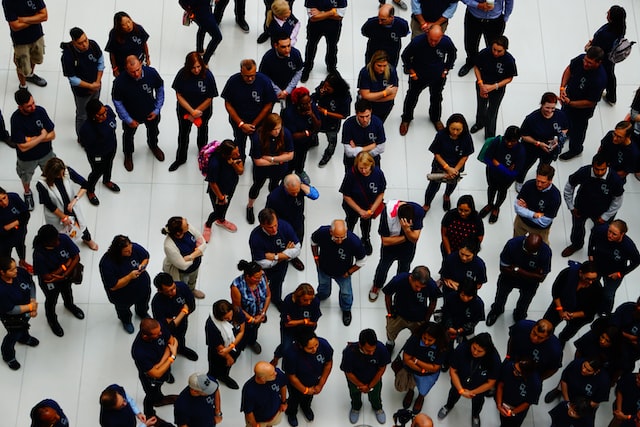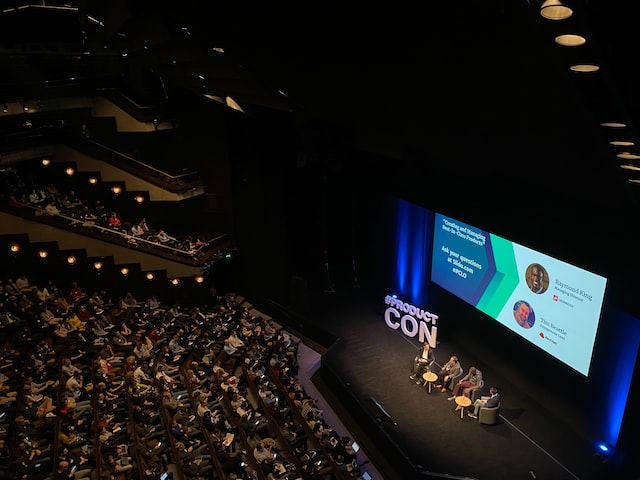Skift Take
Bad icebreakers feel like forced summer camp activities, while good icebreakers are the seeds of amazing friendships, business partnerships, and more. To help you break the ice in the best possible way, we’ve gathered 48 of the best business networking icebreakers.
Love them or hate them (or tolerate them), icebreakers are an integral part of networking during business events.
To rescue attendees from the awkwardness of independently striking up conversations, planners use icebreakers to help attendees get to know each other. While icebreakers set the tone of your event, they are also one of the first memories attendees have of your meeting, conference, or gathering.
Bad icebreakers feel like forced summer camp activities, while good icebreakers are the seeds of amazing friendships, business partnerships, and more.
So, how do you make sure your icebreakers land on the good end of that spectrum?
We’ve gathered the best business networking icebreakers shared by meeting planners and human resources professionals to share with you to save you from the awkwardness of forcing people to do trust falls.
Top 10 Best Icebreakers for Your Event
Need an icebreaker pronto? Check out our top 10 event icebreakers, covering events of all shapes and sizes and different audiences:
| 1. Like or Loathe 2. One Word 3. Toilet Roll Icebreaker 4. Beach Ball Toss 5. Take a Picture | 6. Tweetable Advice 7. Give the ‘GIF’ of Shares 8. Paper Airplanes 9. Link Building 10. One Lesson |
Criteria for an Engaging Icebreaker
In each of the ten categories, we selected our favorite icebreaker games for events based on several criteria, including:
- Novelty and fun: Icebreakers are often most effective when the crowd hasn’t experienced them before — the same old, same old takes the joy out of it. Make a fresh, bold choice that attendees will remember!
- Ease of setup and timing: Is the game easy to explain and get up and running — without taking too much time? No one wants to spend much time constructing an elaborate setup with complex directions. All of these icebreakers are easy to facilitate.
- Variety: Different icebreakers should address different topics and activities, such as introducing yourself, getting to know each other, or establishing team dynamics.
- Integration with the theme: Great icebreakers are tailored to the event theme, the attendees’ interests, and the agenda. This is a great way to draw relevance to the activities that follow.
Once you’ve considered the criteria, you’re ready to pick the perfect icebreaker for your event.
Select an Effective Ice Breaker for Your Group
When selecting an icebreaker, consider your group’s size, interests, and skills. Along with those, your icebreakers should help further your objectives for the business event and help your attendees fulfill their goals for attending.
Tailor these ideas to your group’s company culture, or use these ideas as a jumping-off point for brainstorming your icebreaker ideas.
Here is a list of the categories we cover in this post. You can click on them to jump to that section.
Simple Icebreaker Questions

Sometimes the simplest icebreakers are the most effective. Here are reasons good questions are the go-to icebreaker of choice:
- They require real conversation.
- They’re quick and don’t require setup or materials.
- They help attendees identify commonalities and start conversations.
- They work with any group size and with limited space.
Questions also work well as time fillers when you’re in a pinch. Keep this list handy, and highlight your favorites or note the corresponding number so you can access them quickly when you need them.
- Are you a sunrise, daylight, twilight, or night person?
- What’s the best thing you’ve ever done?
- If you could go back ten years in your life, would you? Why or why not?
- If you never aged, what age would you want to be for the rest of your life?
- What do you think is missing from your career or life?
- What traits and skills would you add if you could create your own artificial intelligence (AI) manager?
- If everyone had a theme song, what would your manager’s (or substitute someone else) be?
- Pick something out of your personal belongings and share it with the group. Why is it important to you?
- If you could be the leader of an organization, country, entertainment industry, or sport, which would you choose and why?
- What is your most memorable vacation?
Funny Icebreakers

Business events often make people nervous, and sometimes that leads to attendees taking themselves too seriously.
To thwart meeting jitters, consider starting with funny icebreakers. A good laugh helps people connect quickly by letting their serious side take a break.
During a large business event, break into small groups and let funny icebreakers work their magic. Here are instructions for funny icebreakers sure to get some laughs:
2. Like or Loathe Cards
- Write one word on each index card.
- Attach an index card to each attendee’s back without the attendee reading the card.
- Ask a volunteer to go first, and have them stand with their back to the group so the group can read the card.
- Have the volunteer face the group.
- Then, tell the group to introduce themselves to the volunteer—based on how they feel about the word on the volunteer’s card—without telling the volunteer the word.
- One by one, the group should convey their like or dislike of the word.
- For instance, if the word is rollercoaster, a person may say, “You scare me.”
- For added fun, ask the group to mime the word instead of saying it.
- Afterward, take turns sharing what was on each participant’s card.
3. Do Your Own Thing
- Count your attendees.
- Create a list of the same number of simple activities (such as acting like a goat or pretending to skydive) as there are attendees.
- Walk around the room and randomly assign each person an activity.
- They must begin acting when they receive their assigned activity and continue until you tell the group to stop.
- As everyone acts outs their roles, ask them to try to speak with one another in character.
- It’s frustrating to communicate when the room is in chaos. Still, it illustrates what happens when we each act according to our own agenda.
4. Come to My Party
- Announce to the group you’re throwing a party.
- To attend, participants must bring something with them. It can be anything they want, but some people will get in, and others won’t.
- As each potential guest asks the host if they can come to the party with their item, the host says yes or no.
- Eventually, people figure out the similarities behind all of the acceptable things.
- For instance, one attendee is coming to the party and wants to bring an apple. She may. The following person wants to bring a peach. He may not. Someone else may bring a pillow and attend. The similarity is that all the items must have consecutive, duplicate letters in the items, aPPle, piLLow, etc.
- You can use any method of categorization to try and stump your audience.
5. Follow Instructions
- Place a sheet of paper facing down at each seat.
- Listed on it are 10-15 easy activities (such as “shout out your name” or “stand up and sit down”).
- At the top of the sheet is one line that reads, “Read the entire list of activities before starting.”
- The last activity line reads, “Ignore all other activities and only yourself to the person sitting next to you.”
- Tell attendees to flip over their papers and begin the timed test.
- Hilarity ensues as people perform the activities without thoroughly reading the instructions.
6. Telephone (also known as Whisper Down the Lane)
- Ask everyone to form a single file line.
- The first person in line whispers a sentence to the person behind them.
- They can only say it once and may not repeat it.
- The person receiving the message must repeat it to the person behind them.
- If they didn’t hear it or only heard part of it, they should try to make the message as close to what they heard as possible.
At the end of the line, the last person shares what was said to them. It’s hilarious how much the message has been distorted.
Icebreakers for Large Groups

Large groups can be challenging to plan icebreakers for because of the scale and the space’s room layout. When possible, divide your attendees into smaller groups so it’s more likely that everybody is actively involved.
Consider a cabaret-style seating arrangement to make it easier to split into groups. It frees up space which makes it easier to move around the room.
With that in mind, consider these icebreaker ideas that work well for large groups:
7. Candy Bar Discussion Tables
- Place a different kind of candy bar and a discussion question on each table.
- Instruct attendees that no one is to eat them.
- Give each person a snack-size version of the same candy bars.
- Each person should then go to the table with their candy bar. For instance, Milky Ways go to the Milky Way table.
- People at the table should take turns answering the table’s discussion question.
8. Scavenger Hunt
- Create a scavenger hunt bingo card.
- Each card contains multiple statements that could be true about someone, such as “I have a dog.”
- Attendees circulate the room in search of people who the statements are true for.
- The following person must answer “Yes,” if the statement is true or “No,” if the statement is false.
- When they find someone who meets a statement on their card, they initial the space on the card.
- The first person with a full card wins.
9. One Word
- Divide the group into smaller groups or tables. When possible, split up groups that came together.
- Ask them to share one word to describe their _____ (family, job, event, company culture, etc.). The word almost always starts a discussion.
10. Playing Cards
- Give each person a playing card when they enter the room. Use multiple decks if need be.
- Have attendees find people with the same number or face card as them. There will be three others per deck used.
- Then, they must bring everyone in their suit together.
- Once they do this, give them a question to discuss.
11. Live Poll
- Display a multiple-choice question (such as “If you could have one of these superpowers, what would it be: flying, x-ray vision, reading minds, superhuman strength”) on the main screen for people to read as they enter.
- Ask people to use their smartphones to vote, so everyone can watch the results change as more and more attendees answer it.
Icebreakers for Small Groups

Small groups are the ideal environment for icebreakers, as everyone can engage, feel safe, and be seen. In a smaller group, there’s the opportunity to get to know people quickly and spend more time one to one.
Attendees can enjoy deeper discussions, and there’s a better chance participants will remember discussions. To get conversations flowing, try some of these small group icebreakers:
12. Toilet Paper Questions
- Show the attendees a roll of toilet paper.
- Tell the group everybody needs to help themselves to a minimum of one square of toilet paper to prepare for the next task.
- Pass around the roll of toilet paper so people can gather their squares.
- Then tell the group that they have to share as many facts about themselves as squares of toilet paper they have.
13. Ten Things in Common
- Give people a piece of paper and a pen.
- Challenge them to circulate the room and ask other attendees questions.
- When they find something in common with someone else, they can write the person’s name down with what they have in common.
- Participants can’t use the same person for all ten things, nor can they use the same question for everyone (such as finding ten people who have cats).
14. The Alphabet
- The leader begins by saying the first letter of the alphabet.
- Then, someone else in the audience says the following letter.
- If two or more people say the same letter at the same time, start over.
- Once your group has successfully made it to Z, try it again with everyone’s eyes closed.
15. Beach Ball Toss
- Write a question on each colored panel of a beach ball with a permanent marker.
- Take turns tossing the ball.
- Whoever catches it answers the question on the panel that their left thumb is touching.
16. Who Is Your Ideal Manager?
- Write the names of famous people (such as Steve Jobs, Oprah, Taylor Swift, Stephen Hawking, etc.) on separate pieces of paper.
- The famous people can be dead or alive. And they can be recognized for sports, entertainment, science, or other things (but it’s probably best to avoid political leaders).
- Ask everyone to go around the room and pick a name.
- Once everyone has chosen, ask each attendee to answer the following question: “If this famous person was your manager, what kind of manager would they be?”
- Allow each person to share their answer with the group.
- Next, ask your group to stand by the name of the person they would most like to be their manager or mentor (if they were available and still living, of course).
- Once in the group, ask them to share the reasoning behind their decision with each other.
- Finally, ask them to compile their best opinions and share them with the other groups.
- If anyone wants to change their mind, tell them to switch managers and encourage attendees to float around if they are persuaded by each group.
- This icebreaker is guaranteed to get people laughing, giving you great insight into what kind of manager people want.
Quick Icebreakers

If you’re on a time crunch or you’re concerned you will lose your audience’s attention by playing hokey games, these quick icebreakers get to the point. They still help folks get to know each other better without wasting valuable learning time.
17. Interesting Questions
Questions are among the quickest icebreakers out there, but you don’t have to wander about asking person after person. There are a variety of ways to use questions as quick icebreakers, such as:
- Display them onscreen and encourage people to talk about them at their tables or with the people sitting directly behind them.
- Add them as a poll in your event app.
- Print a question on each nametag. Or instruct the attendee to add a question other attendees can ask them when they meet (such as Jane Smith: Ask me about my most embarrassing moment).
- Provide a prompt to discuss during the refreshment break (for example, What have you done for the first time this year?). When the event reconvenes, the host can ask for a recap of the most interesting and exciting responses.
18. Cartoon Nametags
- Place a different cartoon (or comic) character on each blank nametag instead of names.
- Encourage each attendee to choose the character that best fits them.
- Then, ask them to write their name below the character’s name and leave the nametag on for the rest of the event.
- It’s an effective conversation starter for social events that don’t need formally printed name badges.
19. 5-Words
- Participants must explain what they do or who they are in five words or less.
- Buzz them if they go over the word count.
- For even more fun, use a cowbell. Everyone needs more cowbell.
20. Take a Picture
- Instruct attendees to use their smartphones to take a selfie with a colleague they don’t know.
- Ask them to share it under a hashtag, on your page, or in your group.
21. Flashcard Answers
- Give everyone five cards with a person written on each one. Anyone can be on the list. But try to be broad enough that everyone knows someone from that category (such as a boss, a significant other, a parent, a pet, a mail-delivery person, etc.).
- Next, ask attendees to answer rapid-fire questions using one of their cards.
- Make the questions as unexpected as possible (such as “the person I would most like to go skydiving with” or “the person I could never send on a peacekeeping mission”).
Icebreakers for Virtual Meetings

Maybe your attendees are miles away from each other, but that doesn’t mean you can’t help foster connection. Since virtual meeting mechanics and social norms are different from a face-to-face environment, consider activities that create an atmosphere of community rather than a one-sided conversation.
The chat feature and video are excellent for sparking side conversations. Check out these suggestions for using them during virtual meetings to spark attendee interactions:
22. How’s the Weather?
- Ask attendees to describe their weather (or day) with an emoji in the chat box or take a poll asking them what season is their favorite.
- Comment on the responses as they roll in.
23. Where are you from?
- Ask attendees to use an emoji in the chat to describe where they’re from.
- Then, guess where people are from.
24. What’s Your Favorite?
- Encourage attendees to share their favorite recent purchases.
- Follow up, if time allows, with requests for other favorites (such as favorite apps, tech, etc.).
25. Reflect & Predict
- Use your virtual meeting as an opportunity for goal setting.
- Ask your attendees what they are proudest of from the past year and what they look forward to most in the year ahead.
26. Show and Tell
- Share your current favorite picture on your phone with attendees and explain why it is.
- Then, encourage attendees to share their favorites using a specific hashtag or uploading to your event app.
27. Two Truths and a Lie
- Ask for a volunteer to go first, or go first yourself.
- Ask the volunteer to state two truths and a lie and to see if other attendees can guess the lie.
- Take turns as many times as the schedule allows.
28. The Ultimate Question
- Ask attendees, “What’s the right way to hang the toilet paper roll?”
- Watch as chaos and fun begins.
Conference Icebreakers

Conferences can be intimidating for introverts and people who don’t know anyone yet. Because of that, consider taking steps to help these attendees feel relaxed and welcome.
Conferences often involve hundreds of attendees, and it’s easy for people to get lost in the crowd. So, the goal is to get people circulating. Here are a few corporate event icebreaker games to get you started:
29. Photo Contest
- Before attendees arrive, take 5-10 pictures of places around the conference room, venue, or hotel.
- Crop and zoom so they are harder to recognize.
- Then, ask attendees to guess where each photo was taken.
- They can do this activity in the room or split up and send teams on a photography hunt to locate these spots.
30. Registration Data Sleuthing
- Once RSVPs or registrations start coming in, compile a list of facts about your attendees.
- Add the facts, one by one, to separate slips of paper and shuffle them.
- Give each attendee one of the clue slips.
- Then, challenge attendees to find one another (such as, “Find the person who graduated from Duke”).
- When they find each person, they will have the person associated with the clue sign their slip of paper.
- Then, they will race back to get the next question.
- The first person to solve them and get them signed wins a prize.
31. Problem & Solution
- When people check in, ask them to add a problem they’re struggling with or something they want on their name badge.
- They should also add one thing they are an expert in (for example, someone might want help learning to speak in public more confidently, and they may be a gaming expert).
- As they mingle, they can use the questions to spark conversations and help each other.
32. Tweetable Advice
- Ask attendees to tweet the best advice they’ve ever been given using the conference hashtag.
- Keep the advice flowing with a new topic (or memes) daily or several times throughout the day.
- Social media icebreakers can increase your social media posts and shares.
33. Give the ‘GIF’ of Shares
Folks love sharing GIFs to represent thoughts, feelings, and wants. So, call for your attendees to share GIFs on social media throughout the day using the conference’s hashtag. Topics can include:
- Opinions of the food at last night’s gala
- Thoughts when their planes landed in the host city
- What they most want to learn at this conference
- How they felt first-thing this morning
- How they feel right now
- Who they’d like to see as next year’s keynote
Icebreakers for Adults

Not every adult wants icebreakers involving red plastic cups and alcohol. Thankfully, there are other ways to loosen up, and these icebreakers will help your attendees find their inner children again:
34. Dynamic Duos
- This works best if you have a rapport with the group (or have good data on them).
- Use stickers or write the name of one-half of a famous duo on each attendee’s name tag.
- The attendee then finds the person with the name of the other half of the pair (for example, Alex, who has “Batman”, and Lauren, who has “Robin”, find each other).
- When they meet, they try to determine why you matched them up. (For example, you paired them because they’re from the same hometown.)
35. Paper Airplanes
- Hand each attendee a piece of paper and a pen when they enter.
- Choose two questions and ask them to answer the questions on their paper.
- Then, ask them to fold their papers into airplanes.
- Next, ask them to stand in a circle and launch their airplanes into the center.
- Tell each attendee to pick up one airplane that isn’t theirs and read the answer.
- Finally, ask them to mingle until they find the airplane’s owner.
36. Mystery guest
- Choose a “mystery guest” in advance and record five things about that person.
- Share the facts with the group without revealing the mystery person’s identity, but ensure they know the person is among them.
- It’s their mission to use the five facts to find the person who matches all five.
37. Personal Jeopardy
- Create a Jeopardy-type board (use cardboard or a whiteboard covered with paper or create a slide deck) with categories and dollar values.
- Under each one, place a funny question.
- The host asking the questions must answer the question or defer it to someone specific in the audience.
- If they defer it, the person in the audience must answer.
- Then, that person can select a category for the person who first deferred, and they must answer it this time.
38. First Job
- As each attendee arrives, have everyone write down the title of their first job on a piece of paper.
- Collect the responses from the registrants and shuffle them.
- Then redistribute them while ensuring no one gets their own.
- Next, challenge the group to guess who held that job.
Team-building Icebreakers for Work

How well do your colleagues know each other? Even if they’ve worked together for a while, icebreakers help strengthen team effectiveness and unity.
Icebreaker games for business events are beneficial when new personnel or remote teams don’t regularly work together. By opening the lines of community, you pave the way for brainstorming and contributions throughout the rest of the event.
Here are a few icebreaker activities to bring your teams together:
39. Link Building
- Ask someone to volunteer to stand with their hands on their hips and say a true statement about their lives.
- If anyone in the group also shares that fact, they must link arms to form a chain with the volunteer.
- The person who joins and ends up at the end of the arm chain then says a fact about themselves, and more people link until everyone in the room links to form one large chain.
40. Volunteer
- To positively impact your community, select a cause where your team can make a difference.
- Then, plan a 1-2 hour activity related to the cause that helps break the ice and makes a difference.
- As your team works toward a common goal, they can learn about each other as they chat.
- If this is a corporate event, select people to be team leaders who are not usually in a leadership position.
41. Holey Tarp
- Gather several people around a 5’x5’ tarp that has a few holes slightly larger than a golf ball cut into it.
- Each person should have both hands grasping the tarp.
- Label one corner of the tarp Point A and the farthest corner from Point B.
- Between the two corners, draw a curved line that is very close to the holes.
- Give the group a golf ball.
- Ask them to place it at Point A.
- By raising and dropping the tarp, they’ll work together to follow the curved path with the ball without it falling into any of the holes.
- The first group to get the ball from Point A to Point B without losing the ball in a hole wins.
42. Spaghetti Tower
- Give each team 20 sticks of spaghetti (uncooked), a marshmallow, a yard of string, and a yard of tape.
- They can combine these pieces any way they would like as long as the marshmallow goes on top.
- The group that builds the tallest, freestanding tower wins.
43. Jigsaw Puzzle
- Gather jigsaw puzzles of different sizes and difficulty.
- Aim for puzzles with 50 pieces or fewer (roughly the number of attendees).
- Each attendee gets a random puzzle piece upon check-in.
- Leave any extra pieces on the table to use as starter pieces.
- Then challenge everyone to work together to assemble the puzzle by mingling to learn what kind of pieces the others have.
- As they mingle, they can work to solve the puzzle as quickly as they can.
- This activity helps to promote unity and deter the forming of cliques.
Opening Icebreakers for Meetings

When planning effective meetings, kick-starting the meeting with a powerful and engaging activity is a great way to set the tone. These opening activities for meetings that energize the room work well for networking and corporate events:
44. Nuts and Bolts
- Give every attendee a small item (such as a nut or a paperclip).
- Then, send them off to circulate in search of their matching piece (In the case of the nut, they’d search for a bolt that fits, and the paperclip would find a piece of paper).
45. Speed Networking
- This is a new spin on an old idea. Seat each person across from someone else at a table.
- Standing room only? Improvise and specify that attendees need to find someone nearby who they don’t already know and haven’t spoken to.
- Give each couple three minutes to find two things they have in common or ways they could help each other.
- Since it’s timed, some hilarious and helpful scenarios unfold.
- This can be repeated a few times to fill the available time.
46. Speed Preferences
- Before the event, create a questionnaire of 5-10 questions that can be answered with brief either/or answers (such as “Do you prefer to work in large groups or small teams?”).
- Have attendees take turns in the hot seat.
- They should answer the questions as quickly as possible — there’s no time to think, only react.
- To help attendees find like-minded attendees, group people based on how they answered each question.
47. Snowball Fight
- Just as it sounds, loosen attendees up with a snowball fight.
- Ask each person to crumple up a non-important piece of paper.
- As the music starts, begin throwing.
- Keep picking them up and throwing them until the music stops.
- Go ahead. Try to keep a straight face.
48. One Lesson
- Divide people into smaller groups or duos.
- Ask them what they hope to get from this meeting or what they want to learn.
- Give them time to discuss it among themselves.
- Then, ask them to come up with a question about what they want to know.
- During the session, they should listen for answers that satisfy their questions.
- If not, when the speaker opens the floor up to discussion, several questions will be ready.
- Later, they can meet up with their partner or group members to share one action they will take as a result of the event.
- Bonus points if they find accountability buddies and follow up with each other after the meeting.
Foster Connections Quickly by Using Icebreakers
Icebreakers used in meetings or business events help attendees loosen up enough to connect and interact with each other. Planners often use icebreakers to set the tone. Doing so promotes collaboration, trust, and unity among your business event’s attendees.
And there are tons of icebreakers, games, activities, and questions out there. To find the most beneficial for your group or team, select those that fit your event’s culture and learning themes.
What are some of your go-to icebreakers? Share these helpful ideas on social media and join the conversation to let us know what worked for you.
Photo credit: krakenimages / Unsplash





